Multistate Outbreak of E. coli O157:H7 Infections Associated with Lebanon Bologna (FINAL UPDATE)
NOTICE: This outbreak is over. The information on this page has been archived for historical purposes only and will not be updated.
Posted March 23, 2011
Outbreak Summary
CDC is collaborating with public health officials in many states and the U.S. Department of Agriculture’s Food Safety and Inspection Service (USDA/FSIS) to investigate a multistate outbreak of Escherichia coli O157:H7 infections. Investigators are using DNA analysis of E. coli O157:H7 bacteria obtained through diagnostic testing to identify cases of illness that may be part of this outbreak.
As of March 22, 2011, 14 persons infected with the outbreak strain of E. coli serotype O157:H7 have been reported from Maryland (3 cases), New Jersey (2 cases), North Carolina (1 case), Ohio (2 cases) and Pennsylvania (6 cases). Reported dates of illness onset range from January 10, 2011 to February 15, 2011. Ill persons range in age from 1 to 70 years, with a median age of 13.5 years. Seventy-nine percent are male. Among 13 ill persons for whom information is known, 3 or 23%, reported being hospitalized, and none have reported hemolytic uremic syndrome (HUS), a type of kidney failure that is associated with E. coli O157:H7 infections. No deaths have been reported.
The outbreak can be visually described with a chart showing the number of people who became ill each day. This chart is called an epidemic curve or epi curve. Illnesses that occurred after March 2, 2011, might not be reported yet due to the time it takes between when a person becomes ill and when the illness is reported. This takes an average of 2 to 3 weeks. Please see the Timeline for Reporting Cases of E. coli O157 Infection for more details.
Investigation of the Outbreak
Collaborative investigative efforts of local, state, federal public health and regulatory agencies have associated this outbreak with eating Lebanon bologna. Lebanon bologna is a fermented, semi-dry sausage. This beef product has an appearance similar to salami. In an epidemiologic study conducted during March 15-18, a total of 13 ill persons answered questions about foods consumed during the days before becoming ill, and investigators compared their responses to those of 21 persons of similar age previously reported to state health departments with other illnesses ("controls"). Ill persons (69%) were significantly more likely than controls (0%) to report eating Lebanon bologna. Additionally, four ill persons have been identified who purchased Seltzer Brand Lebanon bologna at four different grocery store locations in three states before becoming ill.
Recall Information
Palmyra Bologna Company, of Palmyra, PA, is recalling approximately 23,000 pounds of Lebanon bologna products that may be contaminated with E. coli 0157:H7. Consumers are advised to review the USDA's FSIS Recall Press Release for a list of recalled products and images of the product.
Clinical Features/Signs and Symptoms
Most people infected with E. coli O157:H7 develop diarrhea (often bloody) and abdominal cramps 2-8 days (3-4 days, on average) after swallowing the organism, but some illnesses last longer and are more severe. Infection is usually diagnosed by stool sample culture. While most people recover within a week, some develop a severe infection. A type of kidney failure called hemolytic uremic syndrome (HUS) can begin as the diarrhea is improving; this condition can occur among persons of any age but is most common in children under 5 years old and the elderly. Signs and symptoms of HUS may include fever, abdominal pain, pale skin tone, fatigue and irritability, small, unexplained bruises or bleeding from the nose and mouth, decreased urination and swelling of the face, hands, feet, or entire body. Persons who experience these symptoms and believe they are at risk for HUS should seek emergency medical care immediately.
Advice to Consumers, Retailers, and Others
Consumers should not eat any of the recalled products, and restaurants and food service operators should not serve them. Consumers, retailers, and others who have any of the recalled products should dispose of them in a closed plastic bag placed in a sealed trash can. This will prevent people or animals from eating them.
CDC's Role in Food Safety
CDC leads federal efforts to gather data on foodborne illnesses, investigate foodborne illnesses and outbreaks, and monitor the effectiveness of prevention and control efforts. CDC is not a food safety regulatory agency but works closely with the food safety regulatory agencies, in particular, with FDA and FSIS. CDC also plays a key role in building state and local health department epidemiology, laboratory, and environmental health capacity to support foodborne disease surveillance and outbreak response. Notably, CDC data can be used to help document the effectiveness of regulatory interventions.
Additional Resources
- E. coli Resources for Clinicians
- FoodSafety.gov
- USDA FSIS Notice Regarding Lebanon Bologna [PDF - 3 pages]
Final Case Count Map
Persons infected with the outbreak strain of E. coli O157:H7, by state, as of March 22, 2011 (n=14)

As of March 22, 2011, 14 persons infected with the outbreak strain of E. coli serotype O157:H7 have been reported from Maryland (3 cases), New Jersey (2 cases), North Carolina (1 case), Ohio (2 cases) and Pennsylvania (6 cases).
Final Epi Curve
People infected with the outbreak strain of E. coli O157:H7, by date of illness onset*

*n=14 for whom information was reported as of March 22, 2011
- Page last reviewed: March 23, 2011
- Page last updated: March 23, 2011
- Content source:


 ShareCompartir
ShareCompartir